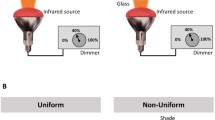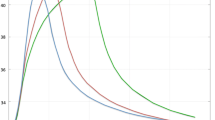Abstract
Extrapolation of thermal sensation (ETS) is a temperature-tuning phenomenon. Heat is felt outside the cold stimulator if given a single warm stimulus for 5 s and then both warm and cold stimulus for 0.5 s, while no such tuning is in reversed condition. The mechanism underlying ETS has not been clarified. We claim a common mechanism based on the transition of the spatiotemporal conditions among ETS, paradoxical heat sensation (PHS), and thermal grill illusion (TGI). We tested whether the addition and unmasking theory in TGI also works in ETS. Percentage hot judgment was found to increase as the temperature difference of stimuli increases, suggesting that hot sensation at extrapolation site can be the result of an addition of non-noxious warm and cold signals. On the other hand, the cold threshold was found to decrease as the distance between warm and cold stimulus increases, suggesting that the unmasking process occurs at the cold site. Our findings suggested that unmasking and addition process involve in the temperature-tuning phenomenon (ETS, TGI, and PHS) at the site with and without physical stimulation, respectively. The co-work of two processes forms a gate control model of temperature.
This research was supported by JSPS KAKENHI Grant-in-Aid for Scientific Research (A) Grant Number 19H01121.
Access this chapter
Tax calculation will be finalised at checkout
Purchases are for personal use only
Similar content being viewed by others
Notes
- 1.
In the pilot experiment, ETS occurred most frequently when the two stimuli were applied at the DIP and PIP joint.
References
Berg, S.L.: Magnitude estimates of spatial summation for conducted cool stimuli along with thermal fractionation and a case of secondary hyperalgesia. The Florida State University (1978)
Bouhassira, D., Kern, D., Rouaud, J., Pelle-Lancien, E., Morain, F.: Investigation of the paradoxical painful sensation (‘illusion of pain’) produced by a thermal grill. Pain 114(1–2), 160–167 (2005)
Cataldo, A., Ferrè, E.R., Di Pellegrino, G., Haggard, P.: Thermal referral: evidence for a thermoceptive uniformity illusion without touch. Sci. Rep. 6, 35286 (2016)
Craig, A.: Pain mechanisms: labeled lines versus convergence in central processing. Annu. Rev. Neurosci. 26(1), 1–30 (2003)
Craig, A., Bushnell, M.: The thermal grill illusion: unmasking the burn of cold pain. Science 265(5169), 252–255 (1994)
Craig, A., Krout, K., Andrew, D.: Quantitative response characteristics of thermoreceptive and nociceptive lamina i spinothalamic neurons in the cat. J. Neurophysiol. 86(3), 1459–1480 (2001)
Craig, A., Reiman, E.M., Evans, A., Bushnell, M.C.: Functional imaging of an illusion of pain. Nature 384(6606), 258–260 (1996)
Ferrè, E.R., Iannetti, G., van Dijk, J., Haggard, P.: Ineffectiveness of tactile gating shows cortical basis of nociceptive signaling in the thermal grill illusion. Sci. Rep. 8(1), 1–7 (2018)
Green, B.G.: Localization of thermal sensation: an illusion and synthetic heat. Percept. Psychophys. 22(4), 331–337 (1977)
Green, B.G.: Synthetic heat at mild temperatures. Somatosensory Motor Res. 19(2), 130–138 (2002)
Green, B.G.: Temperature perception and nociception. J. Neurobiol. 61(1), 13–29 (2004)
Greenberg, S.A.: The history of dermatome mapping. Arch. Neurol. 60(1), 126–131 (2003)
Greenspan, J.D., Kenshalo, D.R.: The primate as a model for the human temperature-sensing system: 2. area of skin receiving thermal stimulation (spatial summation). Somatosensory Res. 2(4), 315–324 (1985)
Greenspan, J.D., Taylor, D.J., McGillis, S.L.: Body site variation of cool perception thresholds, with observations on paradoxical heat. Somatosensory Motor Res. 10(4), 467–474 (1993)
Hansen, C., Hopf, H., Treede, R.: Paradoxical heat sensation in patients with multiple sclerosis: evidence for a supraspinal integration of temperature sensation. Brain 119(5), 1729–1736 (1996)
Harper, D.E., Hollins, M.: Coolness both underlies and protects against the painfulness of the thermal grill illusion. PAIN® 155(4), 801–807 (2014)
Harper, D.E.: Psychophysical examination of the thermal grill illusion. Ph.D. thesis, The University of North Carolina at Chapel Hill (2014)
Ho, H.N., Watanabe, J., Ando, H., Kashino, M.: Mechanisms underlying referral of thermal sensations to sites of tactile stimulation. J. Neurosci. 31(1), 208–213 (2011)
Hua, J., Furukawa, M., Maeda, T.: Extrapolation of thermal sensation and a neuron-like model based on distribution difference and interactions of thermoreceptors. In: 2021 IEEE World Haptics Conference (WHC), pp. 43–48. IEEE (2021)
Jones, L.A., Ho, H.N.: Warm or cool, large or small? The challenge of thermal displays. IEEE Trans. Haptics 1(1), 53–70 (2008)
Kenshalo, D.R., Gallegos, E.: Multiple temperature-sensitive spots innervated by single nerve fibers. Science 158(3804), 1064–1065 (1967)
Khasabov, S.G., Cain, D.M., Thong, D., Mantyh, P.W., Simone, D.A.: Enhanced responses of spinal dorsal horn neurons to heat and cold stimuli following mild freeze injury to the skin. J. Neurophysiol. 86(2), 986–996 (2001)
Melzack, R., Wall, P.D.: Pain mechanisms: a new theory. Psychosoc. Process. Health Reader 112–131 (1994)
Moayedi, M., Davis, K.D.: Theories of pain: from specificity to gate control. J. Neurophysiol. 109(1), 5–12 (2013)
Prescott, S.A., Ma, Q., De Koninck, Y.: Normal and abnormal coding of somatosensory stimuli causing pain. Nat. Neurosci. 17(2), 183–191 (2014)
Stevens, J.C., Okulicz, W.C., Marks, L.E.: Temporal summation at the warmth threshold. Perception Psychophys. 14(2), 307–312 (1973)
Susser, E., Sprecher, E., Yarnitsky, D.: Paradoxical heat sensation in healthy subjects: peripherally conducted by a\(\delta \) or c fibres? Brain 122(2), 239–246 (1999)
Yosipovitch, G., et al.: Paradoxical heat sensation in uremic polyneuropathy. Muscle Nerve Off. J. Am. Assoc. Electrodiagn. Med. 18(7), 768–771 (1995)
Author information
Authors and Affiliations
Corresponding author
Editor information
Editors and Affiliations
Rights and permissions
Copyright information
© 2023 The Author(s), under exclusive license to Springer Nature Switzerland AG
About this paper
Cite this paper
Hua, J., Furukawa, M., Maeda, T. (2023). The Central Mechanism Underlying Extrapolation of Thermal Sensation. In: Wang, D., et al. Haptic Interaction. AsiaHaptics 2022. Lecture Notes in Computer Science, vol 14063. Springer, Cham. https://doi.org/10.1007/978-3-031-46839-1_9
Download citation
DOI: https://doi.org/10.1007/978-3-031-46839-1_9
Published:
Publisher Name: Springer, Cham
Print ISBN: 978-3-031-46838-4
Online ISBN: 978-3-031-46839-1
eBook Packages: Computer ScienceComputer Science (R0)




